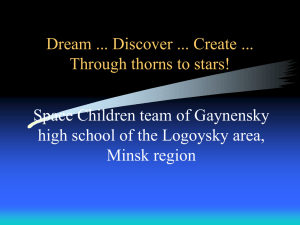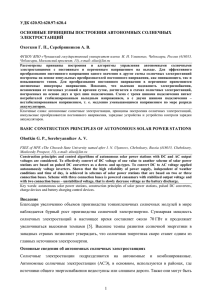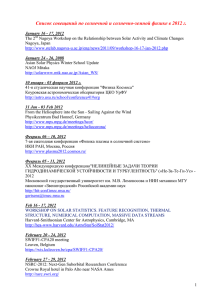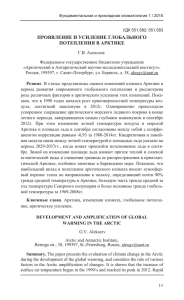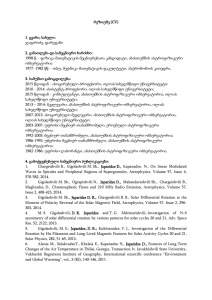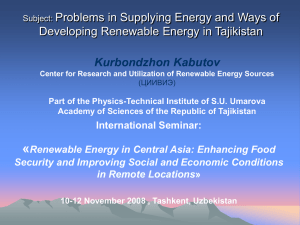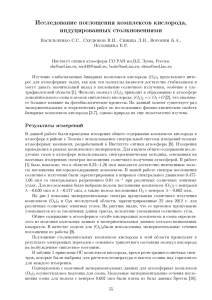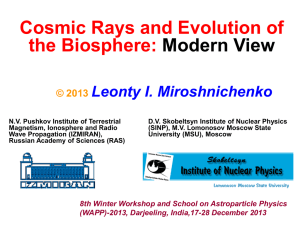ВЛИЯНИЕ ВНЕЗЕМНЫХ ФАКТОРОВ НА КЛИМАТ: ВОЗМОЖНЫЕ
реклама
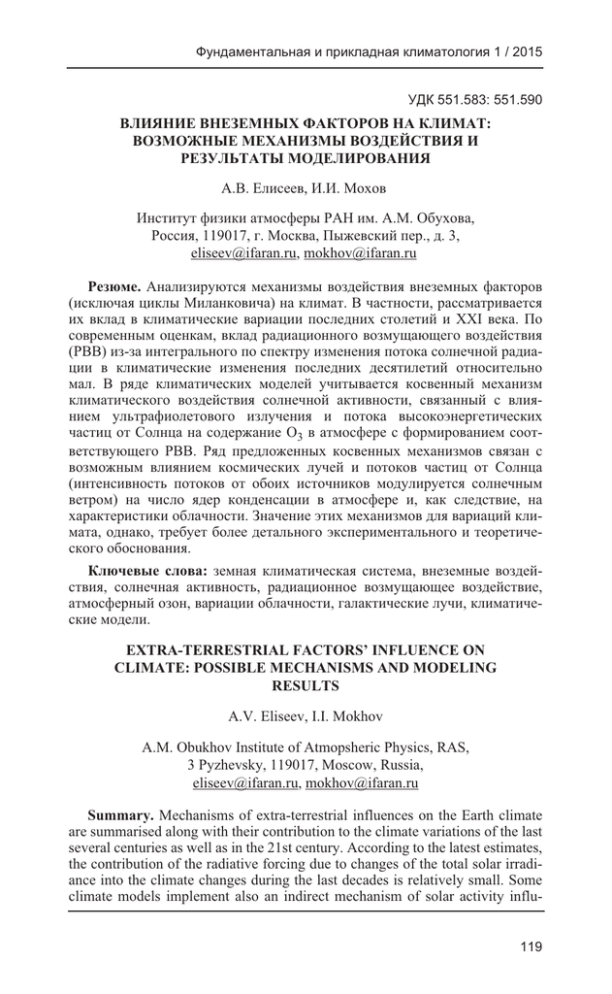
1 / 2015 E_' 551.583: 551.590 >?]@ Z ?: >?h] ?@ >?] >JU >] ?J .. Z, >.>. X% > &# $&! ; $. .X. )%, , 119017, . X, ! ., . 3, [email protected], [email protected] . # $%#$! # #$!% & ( "! X) $. , $ % $ " % XXI . $!$ "$, " #$** # () #-# #$ " $ #$ % $. $% $ ! ! $%#$ $ # , #! $ & # !'% " " O3 $& c &$$ * . !% !% $%#$ # #$!$ $ $% " " ( % $ !$ $) " $& , , % . / '% $%#$ " $, , '$ . : #$ $ $, #$! #, , " #$** #, $&! #, " , , $ $. EXTRA-TERRESTRIAL FACTORS’ INFLUENCE ON CLIMATE: POSSIBLE MECHANISMS AND MODELING RESULTS A.V. Eliseev, I.I. Mokhov A.M. Obukhov Institute of Atmopsheric Physics, RAS, 3 Pyzhevsky, 119017, Moscow, Russia, [email protected], [email protected] Summary. Mechanisms of extra-terrestrial influences on the Earth climate are summarised along with their contribution to the climate variations of the last several centuries as well as in the 21st century. According to the latest estimates, the contribution of the radiative forcing due to changes of the total solar irradiance into the climate changes during the last decades is relatively small. Some climate models implement also an indirect mechanism of solar activity influ- 119 1 / 2015 ence on the Earth climate, which is related to the impact of UV radiation and fluxes of high-energy particles of Solar origin on the O3 atmospheric content; the latter also leads to the development of the specific radiative forcing. A number of suggested additional indirect mechanisms is related to possible impact of galactic rays and fluxes of high-energy solar particles (intensities of both fluxes are modulated by the solar wind) on the number of cloud condensation nuclei in the atmosphere, and, thus, on the characteristics of cloudiness. A role, which the latter mechanisms play in the climate variations, however, needs more detailed experimental and theoretical evidence. Keywords: Earth system, extra-terrestrial influences, solar activity, radiative forcing, atmospheric ozone, variations of cloudiness, galactic rays, climate models. 1 ! #$! &! $ #$ $ $ (/+) # # " #$** # (, #!$ "!$ &$) #-# #$ S0, # !% $%#$, #!% $ " &%$ "! $& $ % ", $ !$ $, $#* "! (. 1) (Benestad, 2006; Gray et al., 2010; Russian National Report ..., 2011; Climate Change, 2013; Solanki et al., 2013). 1 – [& < , < & ( \ , ?). + " (S0), %" ('J), ", & (%5), (>). + " . 55 – " & & . 120 1 / 2015 # $%#$ # #$!% & /+ # $ #$ $ #$ !, !$ # &$ !% ". 2 !$! ( &'!'! &!' 2.1 ! ! (« ! ») ! #$ # S0 $ FS = ¼ S0 (1 – ¥p), ¥p – /$, # # 0,3. " " X ! ' #$$ $ (IPCC AR5) (Climate Change, 2013, c. 696) # 1750-2011. 0,05 ± 0,05 $2. ] # $( ( #) (2,3 /$2 $ 1,1 $-2 3,3 $-2). IPCC AR5 $$ $, ! , ! 1750. XVIII , , %# !$ $ . Z FS ! " ' , # . ), ! $$ " #$** # #-# #$ "$ !$. ;$, FS 2011. XVIII " 0,2 $-2. (Tung et al., 2008) DTg/DSo – $! $&! % Tg #$ S0 11-$ " " 0,12-0,17 + $2 -1, 0,02-0,03 + $2 -1. ' " $% !% $(% #$ $ # ! !( 0,1 +, .. 15% Tg XX . ] '$$ "$ (Lean, Rind, 2008; Benestad, Schmidt, 2009) $!$ #$ (X% ., 2006). '$ (Lean, Rind, 2008) ! $, #$ $ #$ ! LL #! * $( – 0,02±0,01 +/. +$ , $ '!% % # LL $$$$ 11-$ " (Rypdal, 2012) #!(!$ "$ $ "$ (Tung et al., 2008). (X% ., 2012) $ " (% & # ! ( #$ ) " Tg XX . '$ # #$ Tg #$$ S0 $$ $ $!% $(% " #$. 121 1 / 2015 X$$! ($$$ &, 1280-1350 ; $$$ , 1450-1550 ; $$$ X, 1645-1715 ; $$$ D, 1790-1820 .) $ # #$!% % ! ! ( '! – $ (Eddy, 1976). ) * * #$ S0 ' !, !% " $ ' '% # ! * #$ S0 # $ (Climate Change, 2013). (Cubasch et al., 1997) ! $%#$ #$ $ , #! $ #-# ( " % !% $$$ *$ $ "" L' C. ] $%#$ !% !$ $$ $$. ; $ j $ 11- #$ %. , $ $! &! $ $ $$$ Smin $$$ Smax " $$ & 0,5 /$2 (White et al., 2003). ] $ # % * $ " % ( 0,15 /$2). &$ $!% $!% $ #$ &!. # $ !, $, «" %* "» «downward control principle». (Haynes et al., 1991) ""! $ % ! $& "$ !$ &$ !(*% %. , & & $ $ ($. ). # $" $ ! # $* * $& % *% " $& 11-$ " (Barriopedro et al., 2008). 2.2 "# ! $"% ( $$ $$ XXI $ #$ ! (# $ 11- ", % % !% ", $., ., (Climate Change, 2013)). ! " #$ S0 #$ $ XXI #$ $ $ ! ! (X% ., 2008). " #$ '$ ! ! $* !% $ , $- 122 1 / 2015 "$ # SRES (Special Report on Emission Scenarios), ! #! # ( # $ % $ $ (+X) > ;. '$ ! , #$ #$ Tg, #$ $! #!% '$ $ !% #. (Mokhov et al., 2012) ' #! ! ! " ( # RCP (Representative Concentration Pathways), %!*% XXI-XXIII . + #! (Mokhov et al., 2012) #$ (X% ., 2008). #$ $!% , $ ( # " #$ XXI-XXIII % (. 2), #$ % $! ' , $, !$ #$ /+. ] " RCP 2.6, $ # $ $( #(% " RCP (. 3). Z* $( ! #$ S0 XXI-XXIII % "% ( # $ (RCP 4.5, 6.0 8.5). ! #, # " #$ S0 ( XXI $$$ $$$ X) ! (Feulner, Rahmstorf, 2010). 2 – # " " , (Mokhov et al., 2012). 123 1 / 2015 3 – [" " \ >* 8J# #L " RCP 2.6 (Mokhov et al., 2012): 2090-2100. 1990-2000., " S0 ( ), 1 " S0 < " (< ). 2.3 & '# 11- & ! Smax Smin !$ # ERA-40 $ $! , $$!$ $$ 1-2 + % &, $! % &! !% !% ( (Gray et al., 2010). $! ! !$ !$ TOVS, $ $($ $$!$ $$ (Gray et al., 2010). ] #$ $! * *% #$ & $& %( $(!% !% # %$ % (!% #%. ], ", ! $!% #$% $! &!. '$, , $ " $! &! 11- " *$ !$ (($) $ #$ . 124 1 / 2015 #$$ $! 11-$ " #! #$ , , #$ % "!% !% # &! & (Kodera, 1995; van Loon, Labitzke, 2000). "$, ! Smax #$ ! % "" '-D , & % !, – !. ] # & , #, $ &!. ! $$$ " $ . F # # & # &! 11- ! ". )$ 11-$ " &#! #% " (+D[) ' & (#%, #, 2007). # '$ $ , +D[ $ $ & (van Loon, Labitzke, 2000; Labitzke, 2006). >#$ &, , $ % # &! &. ] '&&! $ # $ $ & & % $ ". (Labitzke, 2006) $, ! Smax $ "" '-D , +D[ ' & % &#, # – . ! $% $% (Rind et al., 2008). 3 #! !$!$ # -&'" &!' 3.1 #, # " ' # '# ># !% $%#$ /+ *$ $ ( #! $%#$!, #! $ # $& ( &). , ", #$ S0 11-$ " 0,07% #$ & " ". ] #$ &" &%$ "! # ". F, !$ !$ SAGE II 1985-2003 . !$ #$!% #$ ! Smax Smin $ #$! # 2-4% % & , & ( ( (Soukharev, Hood, 2006; #, , 2007). '$ %, # % %$$ , #! $% $%#$ (#, , 2007). ! !% ! "$ !'% " (!% !() $ #$ &" &$ (HOx NOy), #(*% # (Krivolutsky 125 1 / 2015 et al., 2005; Jackman et al., 2006). !$ !$ HOx $ $( # % & 50% % , NOy – $( # '$ 10% $" (Jackman et al., 2006). #$ % #(* # $ $ &, #( #. #$ " # $ $, , !% (% W (. ) ' $%#$ #$ % ( * /$ % $ ". # '$, $ ' $%#$ * $ . * $ $&!% $ ! %$ " #. $% % $ (Austin et al., 2008) ! , $ #$ 11-$ " * &%$ "! &, ' # * " $! % , $ "$ # #$ # $!. $ SOCOL * $ ! % !'% " " #" $& (Calisto et al., 2011). "$ $ # $( # & !% !(%, $ !(. !% '$% $ * "" INMCM4 ! , " # & 11-$ $ " #$$ % $! $&! $ (Z.X. , *). $, #$ ( 2003.) $ ! SORCE/SIM "$ #$ # 11-$ ", * *$ !% (Haigh et al., 2010). $!$ $, # #$ # '$ " #$. ) *! " 23 !$ $ % !% " # , # % $!% . 3.2 #, # # ' $ (, , 1996; Marsh, Svensmark, 2003; " ., 2008; , , 2009) $! $%#$!, #! $ #$!% & $ # #$ % . , (Marsh, Svensmark, 2003) ($. 126 1 / 2015 ! ' ) #$ !% !% ISCCP D2 $ ! " % % $! $% , $* % % (%. '$ ! , # #" &! # % ". )#* $ #$ ! $ '$$ /$ !$ $ " !% . $ '$ CLOUD, $ CERN (Kirkby et al., 2011). D '#!% # % "! $ ! # !$!$ '# $ (Carslaw et al., 2002). '$ $ % , % , . ) (Sun, Bradley, 2002) $, %!% !% ISCCP D2 " " 22 #$ " 23 ($. (Laken et al., 2012)). , , $ ! # $ % # ! &, *% '&& ' (Tinsley, 2000). "$ H2SO4 & ! * !( " 22, $ " 23. $, (Marsh, Svensmark, 2003) $ ( " $ . + % , !$!% !$ $, $ ! !$ !$, $ !$ ISCCP D2, #!$ (Marsh, Svensmark, 2003). (Kazil et al., 2006) #$ $& $ CCM3, %$ PLOTINUS !% ", #*% !% !(%, " $ '&& $%#$, (Marsh, Svensmark, 2003). ; $, ! **% , *% #!( '&& $%#$. ) '$ "" " #$$, !$ , ! $ " ($ !) & ! Smax Smin !( 1 $-3. ] * $( & "" % 103-104 $-3 (Kondratyev et al., 2006). #$! "" " ! ! &! % ( ( ~104 $-3). ) !* '&& &" &$ !% "" " $, "" !% ! Smax Smin 28%, #* !( 0,24 $-2. ] $ $( " #$ $ 127 1 / 2015 . +$ , $ $( ' # ( ) $ $( % "!% # ( ). C " $ $( $ ' !$ #$ /+. + , $%#$!, #! #" &! $ $ $ !% ", ! #$! #$ $. (, , 1995; , , 2009) !$ "!% $ $( ( , $, 60oN # (- % (# $( ' , $, $ !!$ #$, $, # ). `# - !% !% !( $ '% %. ) # % # ( # %$ ) !$ !$ MISR ! *% #$!% # (Krissansen-Totton, Davies, 2013). (" ., 2008) $ $%#$ $, #! $ !% % #$ ! !( . >#$ $ '$ $* $ " &. ] $%#$ $, $" ' $ !$ !($ #$ $ !% % (Tinsley, 2000). $!$ "$, $&! $ $ % $% #-# ' $%#$, $!% $(% % $" $ ( $, +", 2006). >&! * $ $%#$! #$!% & /+ #! : – $!$ # #$ ; – #$ # $& #$ # % ". ] $%#$! ! % $$ $$, % $ ($ *$. ` !% $%#$, #!% #$ #$!% & % , '$ $ $". ` !% # ! (( 14.Z50.31.0033 > ;), & &$!% $$ ;. 128 1 / 2015 !'"'/" #% .., # .;. 2007. ) # #% #%% ' & . D;, . 415, 6, . 809-813. .., X.>. 1996. " * % !% $% . $#$ '$, . 36, 1, . 153-156. # .;., .. 2007. # 11- " % % * #. >#. ;. # $&! , . 43, 3, . 379-391. " .., + .., X!% .>., " ).., J.. 2008. &#% #$* $ $ % &! /$. +$ , . 46, 4, . 368-377. X% >.>., #% .., Z .., + .. 2006. X! " !% $% #$ XXI $ #!% " " . D;, . 411, 2, . 250-253 X% >.>., #% .., Z .., + .. 2008. X! " #$!% $% #$ XXI #!% "% !% #. +$ , . 46, 4, . 363-367. X% >.>., $ D.., + .. 2012. )" # #$ % $! #!$ !$ !$ &$ !% . D;, . 443, 2, . 225-231. ).X., .. 2009. $ : "! $& ($ 75- X.>. ). $#$ '$, . 49. 2, . 147-155. $ .., +" J.>. 2006. $ $ !% ( (. !! %, . 11, S7, . 96-103 Austin J., Tourpali K., Rozanov E., Akiyoshi H., Bekki S., Bodeker G., Brühl C., Butchart N., Chipperfield M., Deushi M., Fomichev V.I., Giorgetta M.A., Gray L., Kodera K., Lott F., Manzini E., Marsh D., Matthes K., Nagashima T., Shibata K., Stolarski R.S., Struthers H., Tian W. 2008. Coupled chemistry climate model simulations of the solar cycle in ozone and temperature. J. Geophys. Res., v. 113, D11, D11306. Barriopedro D., Garcia-Herrera R., Huth R. 2008. Solar modulation of 129 1 / 2015 Northern Hemisphere winter blocking. J. Geophys. Res., v. 113, D14, D14118. Benestad R.E. 2006. Solar Activity and Earth’s Climate. N.Y.: Springer, 331 pp. Benestad R.E., Schmidt G.A. 2009. Solar trends and global warming. J. Geophys. Res., v. 114, D14, D14101. Calisto M., Usoskin I., Rozanov E., Peter F. 2011. Influence of Galactic Cosmic Rays on atmospheric composition and dynamics. Atmos. Chem. Phys., v. 11, 9, pp. 4547-4556. Carslaw K.S., Harrison R.G., Kirkby J. 2002. Cosmics rays, clouds, and climate. Science, v. 298, 5599, pp. 1732-1737. Climate Change 2013. The Physical Science Basis (Stocker T., Qin D., Plattner G.-K., et al., eds.). ambridge/New York: Cambridge University Press. 2013. 1535 p. Cubasch U., Voss R., Hegerl G.C., Waszkewitz J., Crowley T.C. 1997. Simulation with an O?AGCM of the influence of variations of the solar constant on the global climate. Clim. Dyn., v. 13, 11 pp. 757-767. Eddy J.A. 1976. The Maunder minimum. Science, v. 192, 4245, pp. 1189-1202. Feulner G., Rahmstorf S. 2010. On the effect of a new grand minimum of solar activity on the future climate on Earth. Geophys. Res. Lett., v. 37, 5, L05707. Gray L.J., Beer J., Geller M., Haigh J.D., Lockwood M., Matthes K., Cubasch U., Fleitmann D., Harrison G., Hood L., Luterbacher J., Meehl G.A., Shindell D., van Geel B., White W. 2010. Solar influences on climate. Rev. Geophys., v. 48, 4, RG4001. Haigh J.D., Winning A.R., Toumi R., Harder J.W. 2010. An influence of solar spectral variations on radiative forcing of climate. Nature, v. 467, 7316, pp. 696-699. Haynes P.H., McIntyre M.E., Shepherd T.G., Marks C.J., Shine K.P. 1991. On the "downward control" of extratropical diabatic circulations by eddy-induced mean zonal forces. J. Atmos. Sci., v. 48, 4, pp. 651-678. Jackman C.H., Deland M.T., Labow G.J., Fleming E.L., López-Puertas M. 2006. Satellite measurements of middle atmospheric impacts by solar proton events in solar cycle 23. Space Sci. Rev., v. 125, 14, pp. 381-391. Kirkby J., Curtius J., Almeida J., Dunne E., Duplissy J., Ehrhart S., Franchin A., Gagne S., Ickes L., Kurten A., Kupc A., Metzger A., Riccobono F., Rondo L., Schobesberger S., Tsagkogeorgas G., Wimmer D., Amorim A., Bianchi F., Breitenlechner M., David A., Dom130 1 / 2015 men J., Downard A., Ehn M., Flagan R.C., Haider S., Hansel A., Hauser D., Jud W., Junninen H., Kreissl F., Kvashin A., Laaksonen A., Lehtipalo K., Lima J., Lovejoy E.R., Makhmutov V., Mathot S., Mikkila J., Minginette P., Mogo S., Nieminen T., Onnela A., Pereira P., Petaja T., Schnitzhofer R., Seinfeld J.H., Sipila M., Stozhkov Y., Stratmann F., Tome A., Vanhanen J., Viisanen Y., Vrtala A., Wagner P.E., Walther H., Weingartner E., Wex H., Winkler P.M., Carslaw K.S., Worsnop D.R., Baltensperger U., Kulmala M. 2011. Role of sulphuric acid, ammonia and galactic cosmic rays in atmospheric aerosol nucleation. Nature, v. 476, 7361, pp. 429-433 Kazil J., Lovejoy E.R., Barth M.C., O'Brien K. 2006. Aerosol nucleation over oceans and the role of galactic cosmic rays. Atmos. Chem. Phys., v.6, 12, pp. 4905-4924. Kodera K. 1995. On the origin and nature of interannual variability of winter stratospheric circulation in the northern hemisphere. J. Geophys. Res., v.100, D7, pp. 14077-14087. Kondratyev K.Ya., Ivlev L.S., Krapivin V.F., Varotsos C.A. 2006. Atmospheric aerosol properties: Formation, processes and impacts. Berlin/Heidelberg/New York: Springer, 572 pp. Krissansen-Totton J., Davies R. 2013. Investigation of cosmic raycloud connections using MISR. Geophys. Res. Lett., v. 40, 19, pp. 5240-5245. Krivolutsky A., Kuminov A., Vyushkova T. 2005. Ionization of the atmosphere caused by solar protons and its influence on ozonosphere of the Earth during 1994-2003. J. Atmos. Solar. Terr. Phys., v. 67, 1-2, pp. 105-117. Labitzke K. 2006. Solar variation and stratospheric response. Space Sci. Rev., v. 125, 1-4, pp. 247-260. Laken B.A., Pallé E., §alogovi¨ J., Dunne E.M. 2012. A cosmic rayclimate link and cloud observations. J. Space. Wea. Space. Clim., v. 2, 26, A18. Lean J.L., Rind D.H. 2008. How natural and anthropogenic influences alter global and regional surface temperatures: 1889 to 2006. Geophys. Res. Lett., v. 35, 18, L18701. Marsh N., Svensmark H. 2003. Galactic cosmic ray and El NiñoSouthern Oscillation trends in International Satellite Cloud Climatology Project D2 low-cloud properties. J. Geophys. Res., v. 108, D6, 4195 p. Mokhov I.I., Bezverkhny V.A., Eliseev A.V., Nikitina N.G. 2012. Impact of statistically extrapolated changes in total solar irradiance on results of 21st-23rd projections with a global climate model under RCP scenarios. 3rd International Conference on Earth System Modelling, Hamburg: Copernicus Geselschaft, 3ICESM-63. 131 1 / 2015 Rind D., Lean J., Lerner J., Lonergan P., Leboissitier A. 2008. Exploring the stratospheric/tropospheric response to solar forcing. J. Geophys. Res., v.113, D24, D24103. Russian National Report. 2011. Meteorology and Atmospheric Sciences. 2007-2010 (Mokhov I.I., Krivolutsky A.A., eds.). Moscow: Maks Press, 216 p. Rypdal K. 2012. Global temperature response to radiative forcing: Solar cycle versus volcanic eruptions. J. Geophys. Res., v.117, D6, D06115. Solanki S.K., Krivova N.A., Haigh J.A. 2013. Solar irradiance variability and climate. Annu. Rev. Astron. Astrophys., v.51, pp. 311-351. Soukharev B.E., Hood L.L. 2006. Solar cycle variation of stratospheric ozone: Multiple regression analysis of long-term satellite data sets and comparisons with models. J. Geophys. Res., v.111, D20, D20314. Sun B., Bradley R.S. 2002. Solar influences on cosmic rays and cloud formation: A reassessment. J. Geophys. Res., v.107, D14, 4211 p. Tinsley B.A. 2000. Influence of solar wind on the global electric circuit, and inferred effects on cloud microphysics, temperature, and dynamics in the troposphere. Space Sci. Rev., v.94, 1, pp. 231-258. Tung K.K., Zho J., Camp C.D. 2008. Constraining model transient climate response using independent observations of solar-cycle forcing and response. Geophys. Res. Lett., v. 35, 17, L17707. van Loon H., Labitzke K. 2000. The influence of the 11-year solar cycle on the stratosphere below 30 km: A review. Space Sci. Rev., v.94, 1, pp. 259-278. White W.B., Dettinger M.D., Cayan D.R. 2003. Sources of global warming in the upper ocean on decadal period scales. J. Geophys. Res., v.108, C8, 3248 p. 132


